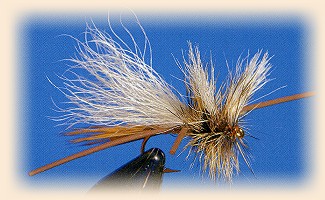The Convertible
By Scott Sanchez, Jackson Hole, WY
The Convertible was born from the need
for a versatile One-Fly pattern. The
Jackson Hole One-Fly competition happens
in early September on the Snake River in
Wyoming and Idaho. The bulk of it is on
the Wyoming side, where the beautiful,
native fine-spotted cutthroats make up
almost 100 percent of the wild trout
population.
This prestigious event allows an angler
to fish one fly for each day of the contest.
If you choose the wrong fly, your fly comes
apart, or you lose it you're out.
I've tied many of the flies for the One-Fly.
I needed a fly for my clients that would
cover multiple conditions, multiple hatches,
and relieve the hysteria of having to choose
a single fly. It's wild how people who make
high-dollar corporate decisions every day can
be brought to their knees by the momentary
dilemma of which fly to tie on to fool a
lowly trout. Fly fishing is a huge priority.
One-Fly conditions on the Snake sometimes
make it difficult to choose a fly. Mornings
are very cool in September; ice in the bottom
of my boat is common. And cutthroats don't wake
early unless nature gives them a reason. This
makes dry-fly fishing slow before midday. Most
hatches occur in the afternoon, so streamers
are a good choice for the predacious Snake River
cutthroats. Also, Claassenia stoneflies
large, nocturnally emerging insects can motivate the fish,
making rubber-leg nymphs a good option. As the
day warms, insects and the fish become more active.
Hecuba mayflies, similar in size
and appearance to a March brown, caddisflies,
and hoppers come into play. Pale morning duns
and blue-winged olives appear in some sections
of river. This conglomeration is a tough bill
for a single fly to fill, and for One-Fly '91,
I had the daunting task of creating a new
"super fly."
It made sense to base the fly on existing
proven patterns. The ability to trim it down
was a given. My answer was to put together a
Woolly Bugger/Tarantula/Trude/Wulff.
I wanted the fly to become a Wulff when it
trimmed down, since Wulffs look enough like
mayflies to work and are excellent Snake River
attractors. To give it bulk, I decided to tie
in a large Trude-style wing and then use the
butts to form the Wulff wing. A marabou
overtail was added for the streamer look, and
of course it had to have rubber legs.
I spent the summer testing The Convertible
against proven flies. Good news: It kept even
with or close to the standards. Surprisingly,
the marabou tail fished well dry. I guess the
trout might have taken it for an injured insect.
I trimmed the fly and fished it in different
forms with very good results. The fly was ready
for the real test.
During the 1991 and '92 contests, various
anglers fished the fly with success and were
pleased with its versatility. In '93, Bob Slamal
of Riverside, California, used the Convertible
to compile the highest point score ever for one
day. He fished the fly intact with the marabou
tail for the entire day the fish were doing
backflips to get it. I needed a name for it
and Convertible seemed logical. One year when
fishing was tough, Brian O'Keefe fished it
intact, then trimmed his fly to a Trude, a
spinner, and finally a nymph. Not many flies
offer that versatility.
Since its creation, the Convertible has
become one of my favorite attractors. It has
evolved into a set of patterns. By pure accident,
I came up with a fly that imitates fluttering
insects. Stoneflies, caddisflies, damselflies,
and dragonflies all have two sets of wings that
are spread when flying. Also, the profile of
lots of wing and legs with a sparse body is
similar to that of a cranefly. During heavy
caddisfly hatches, I think it's eaten as a
caddis cluster.
I hear stories from other anglers about the
Convertible: brook trout and rainbows in Vermont,
cutthroats and bull trout on the Middle Fork of
the Salmon, Kentucky smallmouths. Those are just
a few. The fly has become a standard in Livingston
guides' fly boxes. Bob Slamal calls me every year
for a Convertible order to use when guiding around
Pinedale, Wyoming.
The Convertible is its own clearly visible,
permanently floating strike indicator. It can
be fished and tied with or without the rubber legs;
different kinds of rubber can be used. For
smaller sizes, synthetic wings are an option.
Fish it in its entirety or, if needed, trim it
to a Wulff or Trude. Without legs, a Convertible
doesn't take any longer to tie than a traditional
Trude or Wulff. The advantage is that with this
single fly you now have multiple flies in your box.
Some of my favorite variations are royal, peacock,
blue damsel, salmonfly, yellow Sally, and olive.
The Convertible is a fly that puts you in the
driver's seat.
~ Scott Sanchez
Materials: The Convertible
HOOK: Dai Riki 320 standard dry fly, sizes 8 to 14.
THREAD: Rust-brown UNI 8/0.
TAIL: Elk mane, one shank length.
BODY: Fine tan dubbing over the rear two
thirds of the shank.
RIB: The tying thread, doubled.
LEGS: Brown medium rubber legs, two and a half
shank lengths.
WINGS: White calf tail. The Trude wing should
be one and a half shank lengths and the Wulff
wings one shank length.
HACKLE: Grizzly and brown, one and a half hook gaps.
Tying Instructions: The Convertible
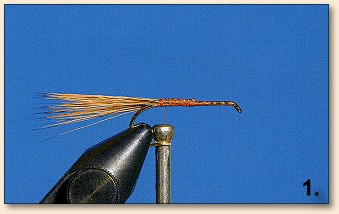
1. Cement the hook shank and wrap a thread base
on it. Even the elk mane and tie it in at the bend
of the hook for a tail one shank-length long.
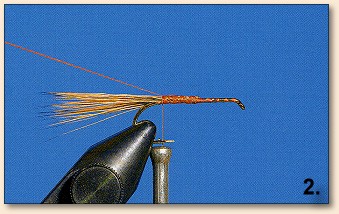
2.Make a dubbing loop with your thread for the rib.
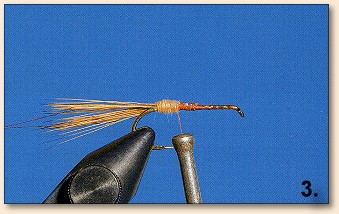
3. Dub the rear quarter of the hook shank.
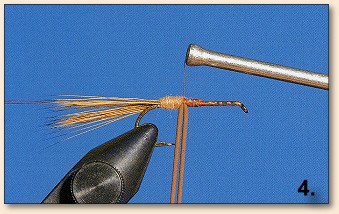
4. Tie in a rubber leg on the near side of the
hook shank. Secure it in the middle of its
length so that it flares into a V.
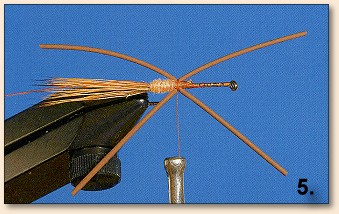
5. Tie in a rubber leg on the far side of the
hook shank. Trim the legs; they should be about
two shank-lengths long from the tie-in point.
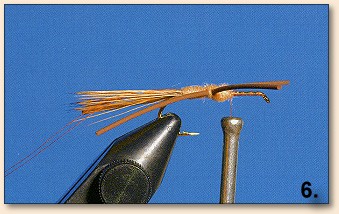
6. Dub through the legs and then make one or two
wraps in front of them; you should now be halfway
up the hook shank.
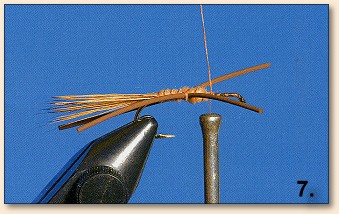
7. Twist the doubled thread and rib the body
with it. Be careful not to trap the rubber legs.
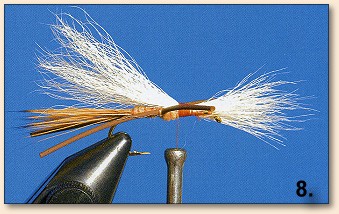
8. Clean and even a bunch of calf tail. Just in
front of the body, tie in a Trude wing that extends
even with the end of the tail.
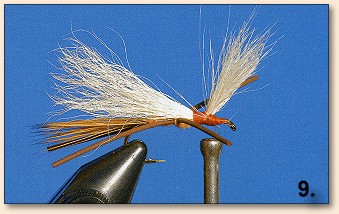
9. Use the butts of the Trude wing to form the
Wulff wings. Wrap your thread in front of the
butts to lift them up.
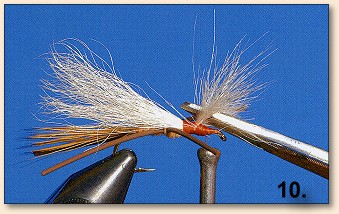
10. Snip out the center third of the Wulff wing
to reduce its profile and to make the two Wulff
wings. Post the wings with thread.
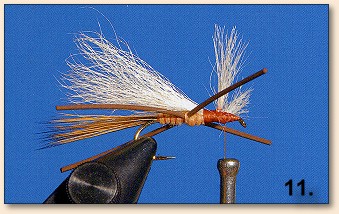
11. Trim the wings to a shank length. I often
trim the ends of the Wulff to make them slightly
uneven and make them look more natural. Taperizer
scissors will also work.
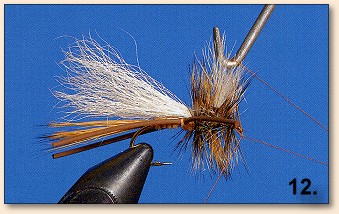
12. Tie in a grizzly and a brown hackle and make
five to six wraps through the Wulff wings. Tie
off the hackle, whip-finish, and cement.
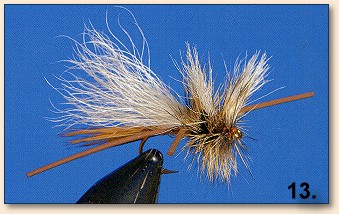
13. The finished fly.
ROYAL CONVERTIBLE
HOOK: Dai-Riki 320 standard dry fly, sizes 8 to 14.
THREAD: Red Wapsi Ultra 70.
TAIL: Moose body hair.
BODY: Alternating Scintilla Peacockle
dubbing and tying thread.
LEGS: Medium black rubber.
WINGS: White calf tail.
HACKLE: Brown.
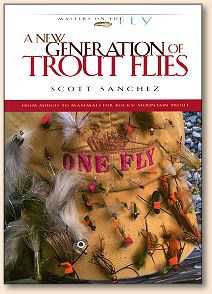
MIDGE CONVERTIBLE
HOOK: Dai-Riki 320 standard dry fly, sizes 14 to 18.
THREAD: Black 10/0.
TAIL: Moose body hair, approximately one shank length.
BODY: Scintilla Peacockle dubbing.
WINGS: White calf tail.
HACKLE: Grizzly.
~ Scott Sanchez
Credits: The Convertible is just one of the many
excellent creative flies in the new book, The New Generation
of Trout Flies by Scott Sanchez, published by
Wild River Press. You can order a hardbound, spiral edition
($39.95)directly from their
website.
|

